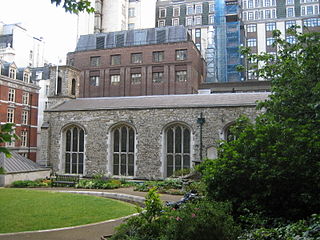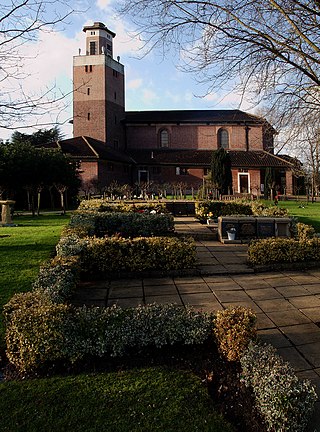
The London Borough of Barnet is a local authority area on the northern outskirts of London. The borough was formed in 1965 from parts of the ceremonial counties of Middlesex and Hertfordshire. It is the second largest London borough by population with 389,344 inhabitants as of 2021, also making it the 17th largest district in England. The borough covers an area of 86.74 square kilometres (33 sq mi), the fourth highest of the 32 London boroughs, and has a population density of 45.8 people per hectare, which ranks it 25th.

Ford Park Cemetery is a 34.5-acre (140,000 m2) cemetery in central Plymouth, England, established by the Plymouth, Stonehouse & Devonport Cemetery Company in 1846 and opened in 1848. At the time it was outside the boundary of the Three Towns and was created to alleviate the overcrowding in the churchyards of the local parish churches. Its official name at the time of inception was The Plymouth, Devonport and Stonehouse Cemetery, although it is now seldom referred to by that title.

Chipping Barnet or High Barnet is a suburban market town in north London, forming part of the London Borough of Barnet, England. It is a suburban development built around a 12th-century settlement, and is located 10+1⁄2 miles (17 km) north-northwest of Charing Cross, 3 miles (4.8 km) east from Borehamwood, 5.2 miles (8.4 km) west from Enfield and 3.2 miles (5.1 km) south from Potters Bar. Its population, including its localities East Barnet, New Barnet, Hadley Wood, Monken Hadley, Cockfosters and Arkley, was 47,359 in 2011.

North Finchley is a suburb of London in the London Borough of Barnet, situated 7 miles (11 km) north-west of Charing Cross.

West Norwood Cemetery is a 40-acre (16 ha) rural cemetery in West Norwood in London, England. It was also known as the South Metropolitan Cemetery. One of the first private landscaped cemeteries in London, it is one of the "Magnificent Seven" cemeteries of London, and is a site of major historical, architectural and ecological interest.

The Kingdom of Hanover was established in October 1814 by the Congress of Vienna, with the restoration of George III to his Hanoverian territories after the Napoleonic era. It succeeded the former Electorate of Hanover, and joined 38 other sovereign states in the German Confederation in June 1815. The kingdom was ruled by the House of Hanover, a cadet branch of the House of Welf, in personal union with Great Britain since 1714. Since its monarch resided in London, a viceroy, usually a younger member of the British royal family, handled the administration of the Kingdom of Hanover.

Friern Hospital was a psychiatric hospital in the parish of Friern Barnet close to a crossroads which had a hamlet known as Colney Hatch. In 1965, it became part of the London Borough of Barnet and in the early 21st century was converted to residential housing as Princess Park Manor and Friern Village. The hospital was built as the Second Middlesex County Asylum and was in operation from 1851 to 1993. After the County of London was created in 1889 it continued to serve much of Middlesex and of the newer county, London. During much of this time its smaller prototype Hanwell Asylum also operated.

Friern Barnet is a suburban area within the London Borough of Barnet, 7.4 miles (11.9 km) north of Charing Cross. Its centre is formed by the busy intersection of Colney Hatch Lane, Woodhouse Road and Friern Barnet Road.

Brunswick Park is a neighbourhood, public park and electoral ward in the London Borough of Barnet. It is north of New Southgate and to the south of Oakleigh Park. Roads include Brunswick Park Road, Brunswick Avenue and Brunswick Crescent.

The Queen's Chapel is a chapel in central London, England, that was designed by Inigo Jones and built between 1623 and 1625 as an adjunct to St. James's Palace, initially as a Catholic chapel for the Infanta Maria Anna of Spain, Holy Roman Empress, and then for Queen Henrietta Maria of England. It is one of the facilities of the British monarch's household religious establishment, the Chapel Royal, but should not be confused with the 1540 liturgical building also known as the Chapel Royal, which is within the palace, just across Marlborough Road. Queen's Chapel is a Grade I listed building.

The King's Chapel of St John the Baptist in the Precinct of the Savoy, also known as the King's Chapel of the Savoy, is a church in the City of Westminster, London. Facing it are 111 Strand, the Savoy Hotel, the Institution of Engineering and Technology and – across the green to its side – the east side of Savoy Street. It is designated as a Grade II* listed building.

The Friern Barnet Grammar School was a small private day school for boys located on Friern Barnet Road, North London.

East Finchley Cemetery is a cemetery and crematorium in East End Road, East Finchley. Although it is in the London Borough of Barnet, it is owned and managed by the City of Westminster.

The Lutheran Church in Great Britain (LCiGB) is a small Protestant Christian church in the United Kingdom. The LCiGB is a member church of the Lutheran World Federation and of The Lutheran Council of Great Britain, the umbrella organisation for several Lutheran churches in Great Britain, many of which are chaplaincies or congregations that are closely related to Lutheran churches in other countries. The LCiGB is also a member of the Porvoo Communion of Anglican and Lutheran churches in Europe. It is, in common with many Lutheran churches, led by a bishop and a council of lay members and clergy elected at its annual synod. Tor Berger Jørgensen, former bishop of the Diocese of Sør-Hålogaland in the Church of Norway, was received as the fourth bishop of the LCiGB on 6 October 2019.
Honouring individuals buried in Westminster Abbey has a long tradition.

St George's Chapel at Windsor Castle in England is a castle chapel built in the late-medieval Perpendicular Gothic style. It is a Royal Peculiar, and the Chapel of the Order of the Garter. St George's Chapel was founded in the 14th century by King Edward III and extensively enlarged in the late 15th century. It is located in the Lower Ward of the castle.

The English coastal city of Brighton and Hove, made up of the formerly separate Boroughs of Brighton and Hove in East Sussex, has a wide range of cemeteries throughout its urban area. Many were established in the mid-19th century, a time in which the Victorian "cult of death" encouraged extravagant, expensive memorials set in carefully cultivated landscapes which were even recommended as tourist attractions. Some of the largest, such as the Extra Mural Cemetery and the Brighton and Preston Cemetery, were set in particularly impressive natural landscapes. Brighton and Hove City Council, the local authority responsible for public services in the city, manages seven cemeteries, one of which also has the city's main crematorium. An eighth cemetery and a second crematorium are owned by a private company. Many cemeteries are full and no longer accept new burials. The council maintains administrative offices and a mortuary at the Woodvale Cemetery, and employs a coroner and support staff.

New Southgate Cemetery is a 22-hectare cemetery in Brunswick Park in the London Borough of Barnet. It was established by the Colney Hatch Company in the 1850s and became the Great Northern London Cemetery, with a railway service running from near Kings Cross station to a dedicated station at the cemetery, similar to the service of the London Necropolis Company to Brookwood Cemetery in Surrey.

The Barnet Tunnel is a railway tunnel in north London on the East Coast Main Line. It has also been known as East Barnet Tunnel, Whetstone Tunnel, and Oakleigh Park Tunnel.






















